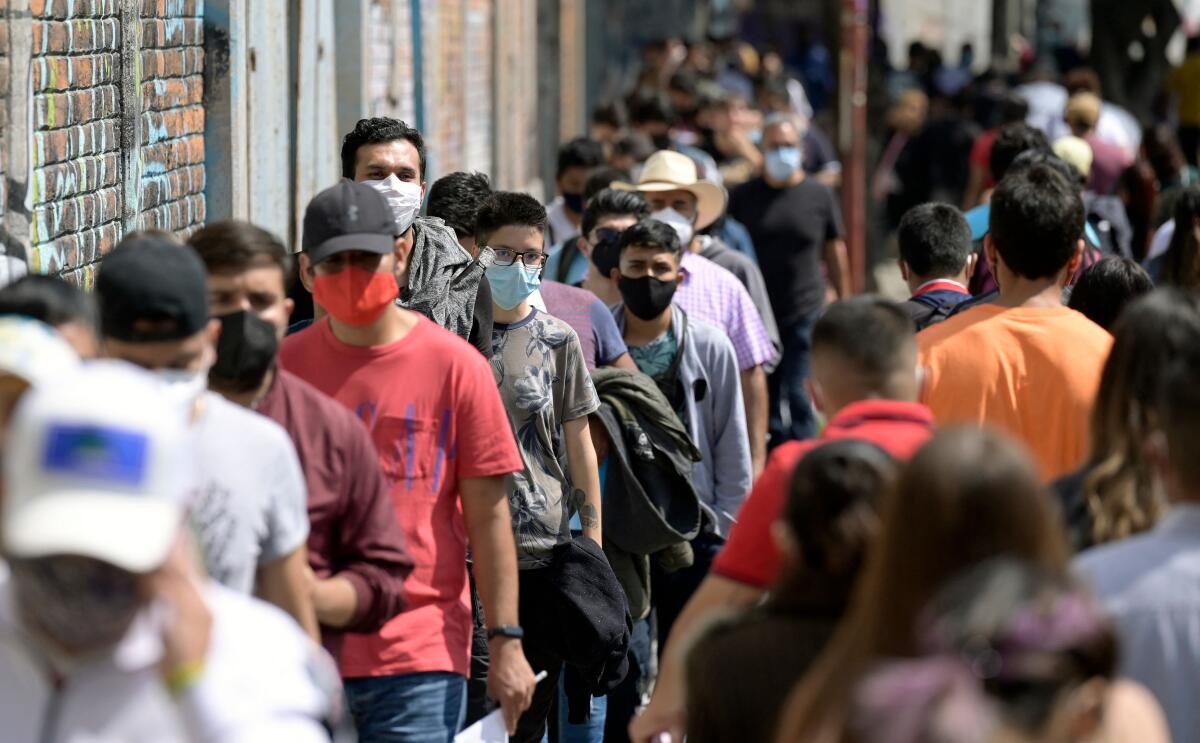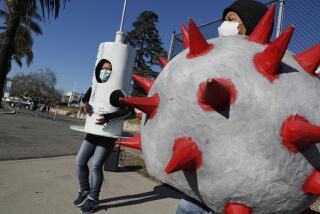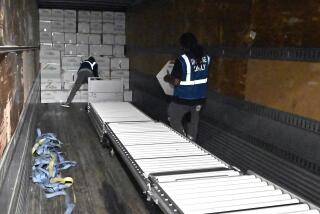San Diego wanted to share unused COVID-19 vaccine with Mexico, but U.S. government said no

- Share via
Coronavirus vaccines have a six-month shelf life, after which medical providers must throw them in the trash.
Those who are trained to administer vaccines go to great lengths to avoid throwing them out, and medical providers across San Diego County thought they had hit on the perfect solution: Send some of those about-to-expire doses to Tijuana or other parts of Baja California where they could find a warm arm before expiring in a cold freezer.
But that idea, Dr. Eric McDonald, the county health department’s chief medical officer, said in a statement Wednesday evening, was shot down by the U.S. government, which has the ultimate say on any such initiative.
“I contacted the White House Vaccine Task Force and was told it was not possible,” McDonald’s statement said.
Asked for an explanation Wednesday, neither the White House nor the federal Health and Human Services Agency had responded to explain the situation as of Friday afternoon. The Washington Post, in a piece about the issue published Friday morning, quoted White House officials as saying the vaccines “are property of the federal government, not the cities or states in which they are distributed” meaning that “the federal government is liable for their use, and the donation efforts must be run out of Washington.”
That explanation was somewhat exasperating for San Diego healthcare providers.
Brett McClain, chief operating officer for Sharp HealthCare, the region’s largest health system, said it was not so much that there are massive supplies of vaccine sitting around and about to expire as there is a collective desire to have a comprehensive plan in place when expiration dates draw near.
“It was more of a conversation around ‘What’s our ongoing process going to be for this?’” McClain said, adding that rumors that Sharp destroyed a large amount of Johnson & Johnson vaccine destined for Mexico are not true.
The Washington Post piece references 10,000 doses that were collected from throughout Southern California and blocked from being sent to Mexicali, though the exact sources are not specified.
According to the California Department of Public Health, the vaccine supply has so far been roughly equal to demand, and San Diego County providers are wasting less than many places in the state and nation.
Roughly 0.6 percent of the nearly 5.2 million doses delivered to the region have been wasted, compared to 1.1 percent of 58 million doses shipped statewide, according to CDPH. And about 4.7 percent of the more than 493 million coronavirus vaccine doses delivered across the U.S. have been wasted, said Katherina Grusich, spokesperson for the Centers for Disease Control and Prevention.
“This rate remains low,” said Grusich in a statement. “Sometimes wastage occurs as part of the process to ensure anyone wanting a vaccine can receive one.”
She points out that the wastage rate is usually 5 to 15 percent for other vaccines administered in multi-dose vials. Along similar lines, a 2019 report from the World Health Organization found that vaccine campaigns typically waste 10 to 15 percent of doses.
Still, there is a desire to share on either side of the border when doses are close to expiring.
San Diego, McClain and others noted, has a close relationship with northern Mexico, especially Baja and its estimated 3.7 million residents. Thousands cross daily on worker visas and green cards, not to mention the million or so American citizens who live south of the border but often come north for shopping and other services.
“There are people who are back and forth across the border every day for work and for other reasons, and they are members of our community,” McClain said. “It behooves us very strongly to try to protect that circle of geography as much as possible; it’s the right thing to do, but it’s also important to do as we get closer and closer to whatever is going to a normal level of vaccination here in San Diego.”
Having traveled to COVID-inundated Tijuana hospitals in 2020 to help his cross-border colleagues, Dr. Jess Mandel, director of pulmonary critical care at UC San Diego Health, said the current policy does not make sense.
“The idea that it’s better to throw out doses rather than help folks across the border who need and want them, it sounds like we should keep thinking creatively on ways to deal with that,” he said.
While he said he understands the federal government’s desire for a universal solution to the expiring vaccine problem, all policies should have room for flexibility.
“I don’t know what people in Detroit and Chicago should do if their vaccines are about to expire, but it’s clear what we can do in San Diego by virtue of our geography,” Mandel said.
Legal liability concerns, he added, seem like they should be surmountable.
“It seems like I sign five liability waivers a week, “ Mandel said. “I just feel like there must be a way.”
Ambassador Carlos González Gutiérrez, the consul general of Mexico in San Diego, said officials on both sides of the border are fully aware of the need to collaborate.
“At the risk of stating the obvious, public health authorities in each country know they have little to no control over whatever public policies are implemented on the other side of the border,” he said. “But they also know that, at a local level, we are talking about a single community. Therefore, local and state authorities are always looking for pragmatic, creative and innovative approaches to common problems.”
At the moment though, the need is greater across Mexico than it is in Baja. About 80 percent of Baja residents are now vaccinated, most with single-dose Johnson and Johnson vaccines. Nationwide, though, Mexico’s vaccination rate is about 40 percent.
It is not as if the United States is generally stingy in its efforts to send doses to other nations. As of Oct. 21, the U.S. State Department lists more than 200 million doses donated to more than 100 countries across the globe. The total for Mexico, according to the state department’s official website, now exceeds 7.5 million. The U.S. Embassy in Mexico puts the total at 10.9 million due to the arrival of an additional 3.4 million AstraZeneca doses recently.
Many who spoke about the cross-border vaccine situation pointed out that, because of the large amount of coming and going by American expatriates and workers living in Mexico, the region will not really get the virus under control until both sides of the border are vaccinated.
But getting to that number already includes some cross-border help. UC San Diego had a vaccination program over the summer that vaccinated about 26,000 maquiladora workers at the San Ysidro port of entry.
Dr. Shira Abeles, an infectious-disease specialist at UCSD, said Friday that the effort, which technically stayed on American soil, was able to function smoothly in late July and early August with workers being brought to the border by bus, monitored for side effects, then sent to their homes and jobs in Mexico.
In the beginning of the vaccination effort, Abeles noted, everyone focused intensely on making sure that leftover thawed doses went into arms and few were wasted. That need to use every drop, she said, has not waned among those pushing the syringe plungers even as vaccine supply has swelled and some have refused to receive their shots.
“We worked really, really hard not to waste a single dose at the beginning, and it still feels like a shame when we have to waste even five doses,” Abeles said.
And the need for countries to share across their borders is bigger than San Diego and Tijuana.
Everyone nationwide has a vested interest in as many doses getting into arms outside the U.S. as possible.
Matt Daugherty, a molecular biologist and assistant professor at UC San Diego who studies viral evolution, noted that one of the biggest factors that determine whether coronavirus will mutate and create additional variants is how many times it infects human hosts. Every time the virus replicates itself inside a human cell there is a very small chance that genetic code will not be copied correctly, resulting in new versions that may, just by chance, end up with a new feature that helps them spread more easily.
The Delta variant that caused many cases in recent months came out of India, where vaccination rates were relatively low and the number of cases was high. Big surges in caseloads in Brazil and South Africa have also spawned variants for similar reasons.
The United States has a serious interest, then, in reducing the amount of infection occurring all across the globe.
“If it’s raging in some places, that means that diversity is still being generated and could easily spill back into areas where it’s currently under control,” Daugherty said. “Everyone needs to understand that control needs to be done at the global level, not just the local level, in order to prevent the next Delta variant from coming along.”
Union-Tribune staff writer Jonathan Wosen contributed to this report.
More to Read
Sign up for Essential California
The most important California stories and recommendations in your inbox every morning.
You may occasionally receive promotional content from the Los Angeles Times.












